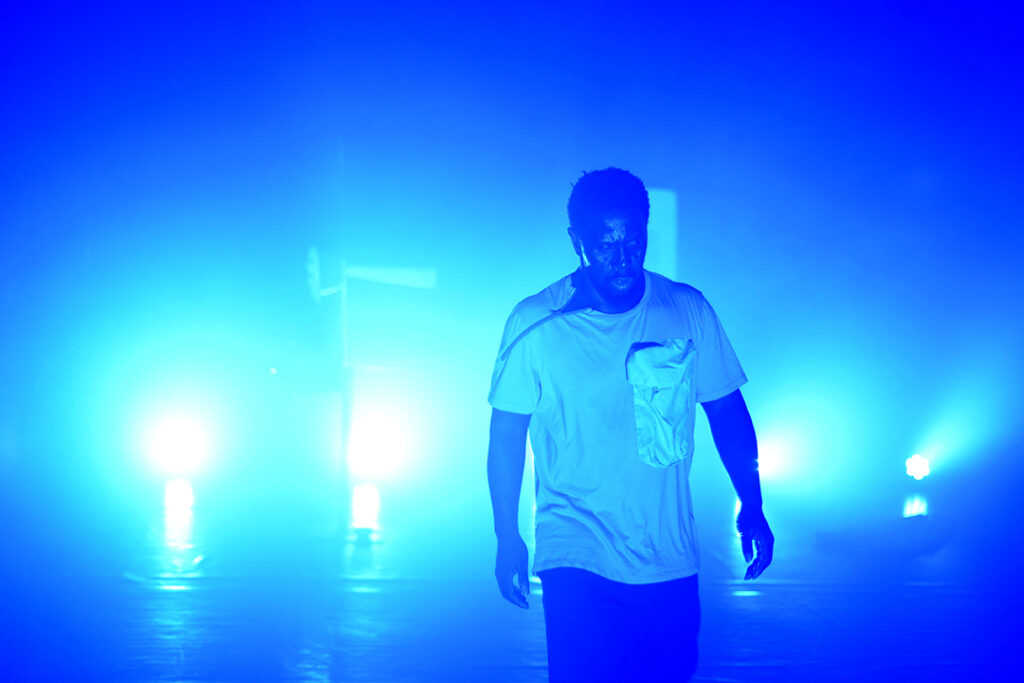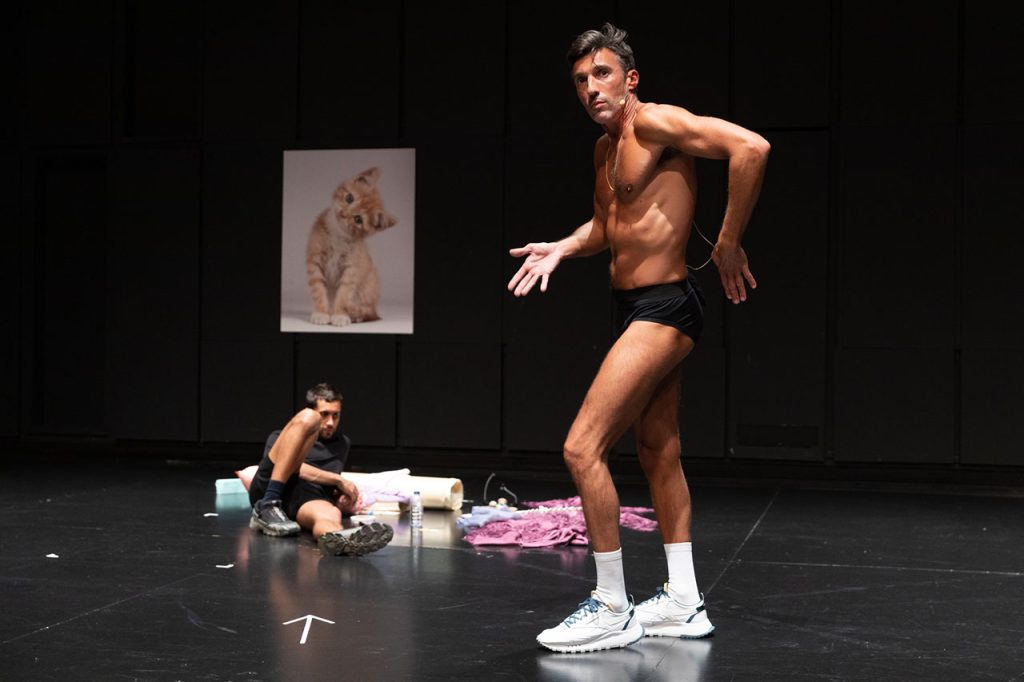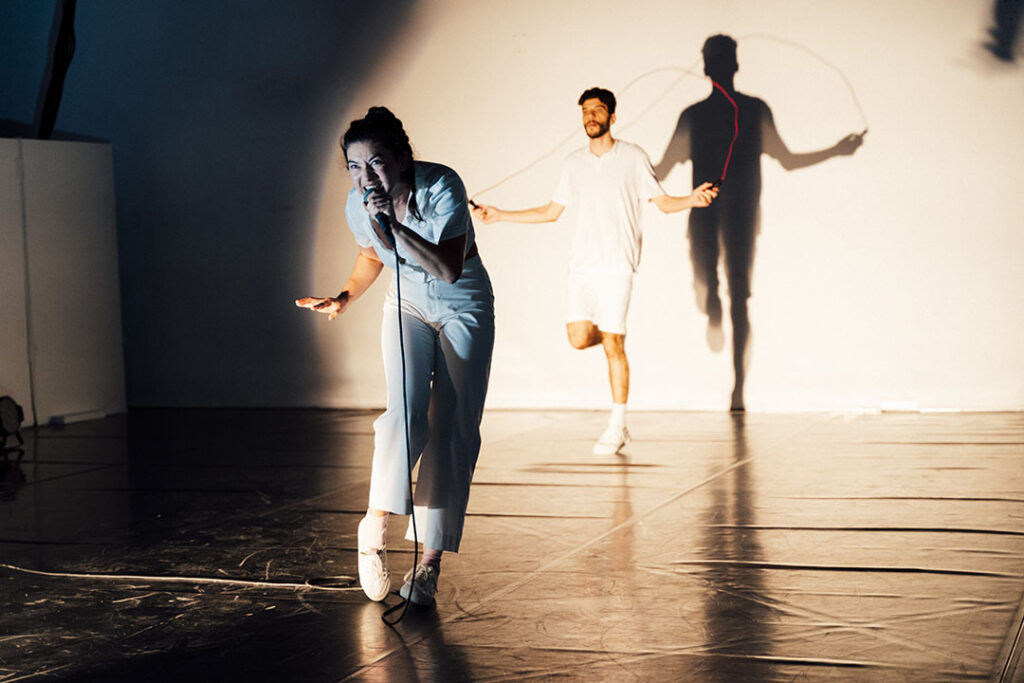Neighbours
Do Gio Lourenço and Bernardo Chatillon know they were neighbours? They both grew up just outside Lisbon in the district of Cascais (not the posh part), Lourenço in the now-demolished enclave known as Bairro do Fim do Mundo (“the neighbourhood at the end of the world”), and Chatillon in the small community of Rebelva, barely a mile to the east. Chatillon was born there in 1982, while Lourenço, born in Angola in 1987, arrived there in 1992, displaced by the long-running colonial and postcolonial conflicts in Angola. In the 80s and 90s and 00s, their neighbourhood was notorious for its social deprivation and drugs. Both men found a route outwards through dance, acting and performance, coincidentally passing through the same dance centre (C.e.m. – Centro em Movimento).


Their shows at PT.23 seemed oddly adjacent too. They were performed at the same time, on the same stage, but on different days. That’s probably mere coincidence. More significantly, the works themselves felt like next-door pieces, like two houses built in a similar way but inhabited by different people and histories. Both Chatillon’s Reindeer Age #1 and Lourenço’s Boca Fala Tropa feature a man in casual streetwear recalling, in movement as well as in words, aspects of his past. Both feature a stage-left musician and set: a percussion kit and synthesiser in Reindeer Age #1, a DJ table in Boca Fala Tropa. The scenography for both has a makeshift, DIY feel: Lourenço’s has a ragged plastic curtain, a random chair, assorted lights and speakers; Chatillon has a smooth plastic curtain, a portable chair and table, a pile of building blocks.
But it’s in the treatment of their own bodies that the two men come closest – not in style, but in approach. Chatillon spells it out near the beginning of his performance. “There is something here,” he says, touching his arms, his chest, his face, his thighs, “that is very very far.” He’s talking about memory, not just in his mind but in his body. Chatillon’s memories are connected above all to his father, and his performance takes him back to the road trips and camping stops of a childhood vacation. Lourenço too finds “something here that is very far”, but the story he tells is markedly different. He uses the jagged, high-voltage, broke-up dance style of kuduru as his medium (it’s how he danced as a child), and connects that to a story that takes in the dislocations of migration and the events of the Angolan civil war.
Chatillon deploys a subtly suggestive language of gesture, combined with naturalistic speech and sound that is variously ambient and nostalgic to suggest a personal and familial history. Lourenço uses a sharp style, highly structured utterances, news reports and forceful rhythms to connect to an almost ungraspably big political history. You could say that one goes inwards, the other outwards. Yet they share this recognition: that the body is a house inhabited by memories, and not just its own ones.
They make an interesting pair, Chatillon’s family with deep roots in his neighbourhood, Lourenço’s with wide roots that span continents, both men with works that share commonalities as well as mark differences. So I wondered how Reindeer Age #1 and Boca Fala Tropa might play together if curated to stand side by side.
But there’s something I should add, without which I would be doing both a disservice: these works were interesting not only or even mainly because of their contexts, concepts and next-door natures, but because they were convincingly performed and thoughtfully composed – each worth seeing in its own right.
Whatever it takes
In his interview with my colleague Maria Teixeira, PT.23 director Pedro Barreiro points to a “whatever works” attitude towards making performance among artists: instead of staying within disciplinary boundaries and hierarchies, they use whatever means, resources, genres and materials that come to hand for their project. The result is a hybrid, rather polyglot performance style that I had certainly been struck by during my previous visit to PT in 2019, as well as here at PT.23. Then, as now, I had the impression that the Portuguese creators deployed this hybridity quite fluently and unselfconsciously: it was not an “issue” for them. In other contexts I’ve been in, such hybridity can come across as a deliberate act of transgression, sometimes with claims to boundary-busting radicalism. Here, it seemed more like a practical matter, something already accepted rather than to be fought for or against. Nice.
Of course, you can have a whatever-it-takes approach, but how and whether it does work in any particular case is a different question (a key one for any critic). But I’m not here as a critic…
Still, I am here with a background in dance, not theatre or performance, and as such I would like to add something in defence of the dancier, not-so-hybrid works at PT.23 (those by Tânia Carvalho, Marco da Silva Ferreira, Daniel Matos and Piny), and it is this. Some media – especially video, text and speech – are typically more attention-grabbing than others, and when put next to dance they often dominate it. It’s as if they suck in the oxygen on stage, and dance makes do with whatever’s left.
So hybrids have their own hierarchies, and sometimes a disciplinary boundary is just what it takes for the piece to work well. In other words, sometimes dance really needs its own time and space.
#transfake
In January 2023, a stage version of Pedro Almodóvar’s All About My Mother playing in a municipal Lisbon theatre came to an abrupt stop in mid-performance. In a planned protest, a trans woman from the audience invaded the stage and denounced the cis (gay) male actor in the role of a trans woman as a “transfake”, demanding that the job go to a trans woman. The curtain came down, the show stopped. After some time, the cast came out in front of the curtain. One cis woman tried to talk with the protestor, and a trans woman in the cast (who was playing the part of a trans woman), made a short, calm statement in solidarity. The role played by the cis male actor was subsequently recast to be played by a trans woman.
The story exploded all over the Portuguese media, and the fallout had all the cluster-bomb consequences that we have come to recognise from culture wars (mudslinging, pile-ons, dig-ins, takedowns, death threats) in which no one emerges unscathed or unscarred. When PT.23 opened, six months later, it was still a bitterly divisive topic in Portugal.
Why I am telling you this? Not because trans performers featured prominently in PT.23 (although they did) but because the opening show was by Gaya de Medeiros, the trans actor in the play, and the penultimate one was by Keyla Brasil, the protestor at the play. The PT jury, programmers and artists would certainly have been aware of the “transfake” backstory, as would many of the guests, so the issue seemed impossible to avoid.
But avoid it we largely did – and perhaps that was wise. Much safer to speak off-the-record than put statements On Record. A few people did mention it to me, to give a certain context to PT.23, but we didn’t go into detail. One person did go further and explain more about how the transfake affair had entrenched divisions into two sides. Unsure of how the person felt about that, I asked. The reply came: “but there is only one side.”
I’m reminded of something said by PT director Pedro Barreiro in an interview with my colleague Maria Palma Teixeira. He was talking about arts funding bodies, not trans bodies, but I think it’s worth hearing: “What is important to always keep in mind is the maintenance of dialogue, goodwill, and an understanding that relations are multilateral and not unilateral.”
I think that the first part of that sentence depends on circumstance (dialogue and goodwill may not be possible or even desirable in the face of violence, for example), but that the second part, about relations being multilateral, is always true. Does that sound like something a psychotherapist or relationship counsellor would say? Well, I do sometimes wonder if, more than political action, we need political therapy.
TMI
TMI is shorthand for “too much information”. It’s usually used when somebody “overshares” their personal stuff with you, but here at PT.23 I thought of it more literally: when the volume of information on stage is simply too much to process.
André e. Teodósio made a point of it in Info Maniac, a sustained, multi-channel blast of talk, speech, gesture, sound and image that was designed to overload us, and even more himself, to beyond maximum capacity. It was quite a feat: Teodósio talked incessantly, splicing subjects together, flitting between memory, commentary and confession, all the while twitching, jerking and bouncing in multi-directional detail, with fingers, face, knees, hips and ankles all angling off in different directions at once. By way of counterbalance, installation designer Bruno Bogarim reclined on the floor throughout, sometimes idly swivelling to watch the manic man beside him, but more often looking as unconcerned as a cat on a rug – a much-needed still point to Teodósio’s turning whirlwind.


TMI was Info Maniac’s deliberate strategy and I, for one, willingly surrendered to its overload. To some extent, Mário Coelho’s I’m Still Excited went for TMI too, packing its scenes with quickfire dialogue that flipped back and forth through various layers of meta-narrative. And yet, I think Coelho was quite adroit at handling this. On the surface, there was lots of gabbling and arguing and jokes and repartee, but underneath, his scene structure was sure and measured: we always felt there was a context for the information being fired at us, so we never felt drowned or lost.
The strategy in Gaya de Medeiros’s BAqUE was to keep interrupting its own information supply. Its scenes were not sequenced through transitions but collaged with jump-cuts: we leapt from quiet to loud, from group to duet, from music to movement to costume to body. De Medeiros wanted her scenes to be interrupted without warning, just as death interrupts life, and she had the great idea of putting these shocks into the dramaturgy itself. Hence cuts, not continuities. Still, for me I’m not sure it worked. Information is only perceived as information to the extent that we make enough sense for it be meaningful. Otherwise, the rest is noise – stimulus without sense. In BAqUE, I may not have got lost, but I did find myself teetering on the cusp between information and noise.
Vânia Doutel Vaz’s Elephant in the Room was the one piece in PT.23 where I did get totally lost – or perhaps never found a way into. Not that its elements were unrecognisable: there was Vaz herself, calmly present in her chair, or laying out her costumes with careful deliberation, and there were songs by Nina Simone and Whitney Houston. Was this too much information? From what I could make out, Vaz’s performance was stitched together through some kind of narration, which seemed to be key – but those of us seated at the back just couldn’t hear it. So perhaps it was not Too Much Information, but simply Not Enough Volume.
Not a cat
There’s an English idiom which goes: “a cat among the pigeons”. Do you know it? It’s when a predator is let loose on the prey. Sometimes, as a dance critic, I feel like – or rather, feel like I’m seen as – a predator. Someone who pounces on artists, and kills them. Or lets them go, if that takes my fancy. So that they can live on – and I can kill them later. If I feel like it. For I am the cat, and they are the pigeons.
Do you recognise that story?
And then there’s me as a dance writer, who interviews artists, or writes a profile of their life or work, or a preview of their forthcoming show, or a text for their theatre brochure. Here I can appear – depending on who you are and how you look at it – as a companion, a helper, an interpreter, a promoter, a messenger, a mouthpiece. But not a cat. Not among pigeons.
At PT.23, what story was I acting in? Not the cat-pigeon one. Four years ago when I was at PT.19, it was as an interviewer, and now once again I was here not to review the stage works, but to talk with people, observe, record and compile, like a documentarian. Once again, it was nice not to be cast as the cat among pigeons. I learned many things through this dove-like role that I might not otherwise have done (I think I even made a friend this way), and I wasn’t obliged to make any public value judgements about any of the work. My job was to try and say some interesting things, in an interesting and pleasurable way. I’ve tried my best, but you’re the judge of that. Kill me if you want.



